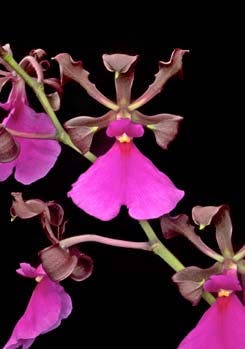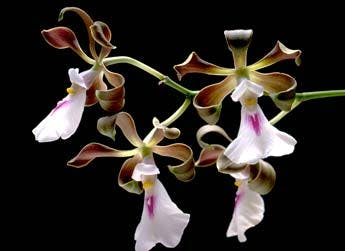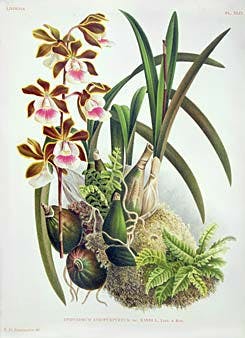Encyclia cordigera (Kunth) Dressler

Desirable flowers have a broad flat lip with rich pure color.
Spring ushers in the beginning of Encyclia season and there are many excellent species in the genus whose peak flowering begins around Mothers Day. One of the favorites is Encyclia cordigera (Kunth) Dressler. Long known as Epidendrum atropurpureum, this beautiful orchid ranges from Mexico, though Central America and Northern South America, and reportedly into Brazil. Like many wide ranging orchids, Encyclia cordigera is adaptable to varying cultural conditions and makes a good subject for hobbyist orchid collections. This species is found in three color forms making it even more desirable.
Encyclia cordigera has traveled a rocky road of nomenclature. Having been orignially described as Cymbidium cordigerum by Humboldt, Bonpland and Kunth in 1815, Reichenbach erroneously misapplied Epidendrum atropurpureum var. roseum to the pink-lipped form, an error that stood well past Dressler's 1964 correction to the current name. To confuse matters even more, Linden published a plate of Epidendrum atropurpureum var. randii picturing a white-lipped Encyclia in Lindenia in 1886. Although Linden acknowledged the obvious differences from Epidendrum atropurpureum, he went on to say "we have not considered there to be any reason for creating a new species". The plant actually pictured in Lindenia is a totally distinct Brazilian species, Encyclia randii, and the epithet "randii" should never be applied to Encyclia cordigera. Yet even today, semi-alba plants of our subject can still be found in the trade labeled as Encyclyia cordigera var. randii. The third color form lacks any anthocyanin pigment and is less commonly seen. Withner describes plants with green petals and sepals and clear white lip as Encyclia cordigera forma leucantha, although in the trade they are usually labeled as var. alba. Major databases only accept Encyclia cordigera (Kunth) Dressler and relegate the color forms as synonyms.

When flowers have a white lip with magenta splotch in the middle, they are often called "semi-alba"' or erroneously, var. randii.
Many consider the large showy flowers of Encyclia cordigera to be the finest in the genus. They have an intoxicating fragrance that varies slightly from plant to plant, but some say the pink-lipped flowers smell like roses. Flowers can last for well over a month. The species has received over 40 AOS awards, both for quality and for culture. The best flowers have a broad, flat, skirt-shaped lip with saturated color for the pink-lipped form, and a well-defined magenta central splotch for the semi-albas. Encyclia cordigera has been used as a parent both within the genus and with other members of the Cattleya alliance to create intergeneric hybrids such as the legendary Epicattleya (syn. Catyclia) Florida, registered by Lewis Vaughn in 1965 (C. dowiana x Enc. cordigera).

Linden's plate in Lindenia depicts the Brazilian species, Encyclia randii.
Encyclia cordigera is easy to grow under a wide range of conditions. Its natural habitats are low-elevation oak forests that are fairly dry and bright. It can be grown in the intermediate temperature range but will do equally well in warmer conditions. The best flowering will occur if plants are grown bright but they will grow and flower under as little as 2000 foot candles. Plants can be potted in a coarse open media but if you have a tendency to overwater, a mount or basket is a preferable option and will maintain healthy roots better. This species does not tolerate stale, dank potting media. The tightly clustered pseudobulbs can be as big as an onion on healthy plants but a mature plant does not take up much space and can be accommodated even in small collections. Like all encyclias, be alert for scale between those tightly packed pseudobulbs. It can get well established before you notice, and then it is more difficult to eradicate. Keeping dry sheaths peeled away makes inspection easier. - AOS Publications Committee
References:
- Carl L. Withner 2000. The Cattleyas and Their Relatives. Volume VI. The South American Encyclia Species. Timber Press, Portland, Oregon.
- Bechtel, Cribb, Launert 1992. The Manual of Cultivated Orchids. The MIT Press, Cambridge, Massachusetts.









